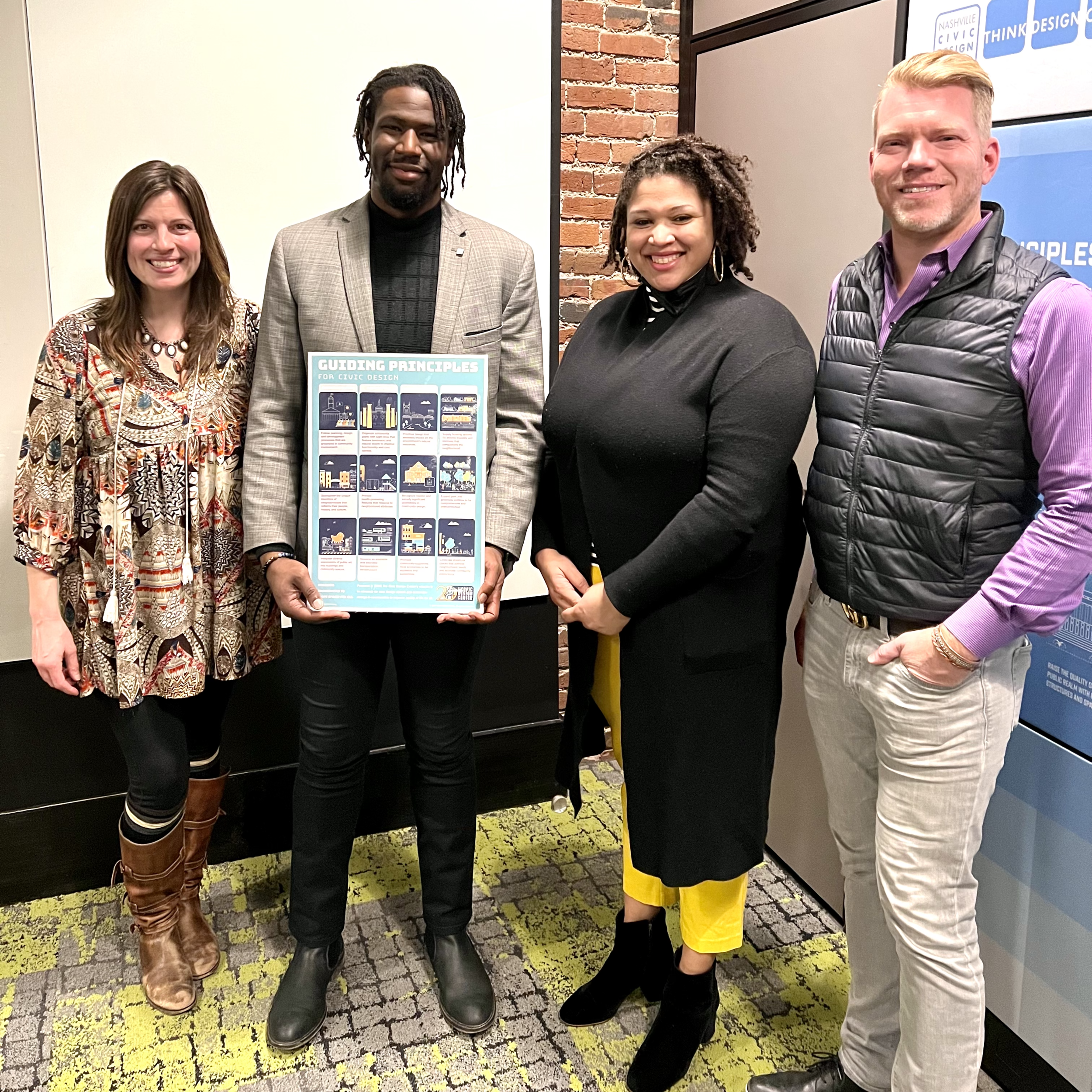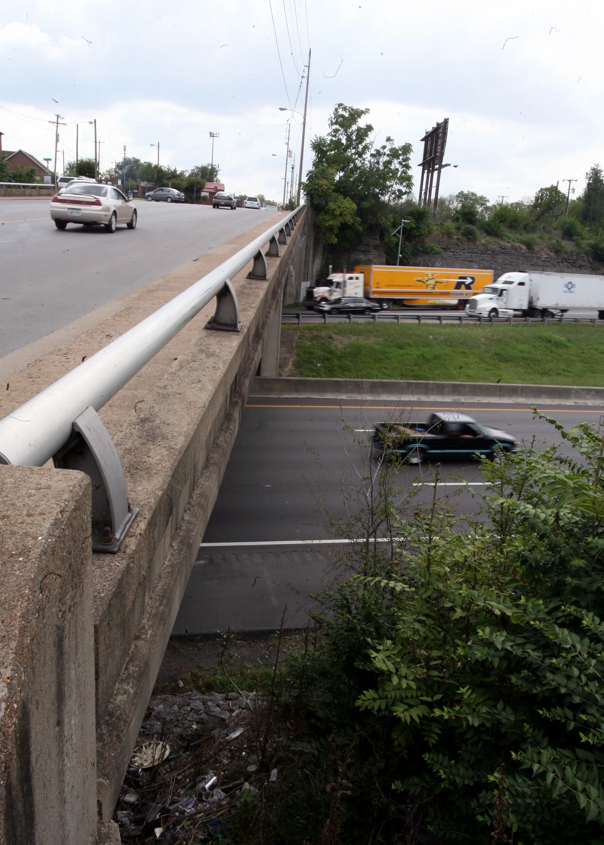Confronting Challenges: Representation
By Savannah Dupper, Writing Coordinator
3 min read Vanderbilt Women in Business Extern, Savannah Dupper, reflects on our first event in the Guiding Principle series, Representation in Civic Design. Read on to hear some of the takeaways. Follow @civicdesignctr on Twitter #RepCivicDesign to review the Live Tweets from the event.
Guiding Principles Pillar #1: RepresentationA community cannot exist without people and their unique perspectives. Therefore, the most basic principle in planning and design must encompass the representation of those identities.
Representation in Action
Ashley Bergeron (from left), Edward Henley III, and Lauren Fitzgerald with CEO, Gary Gaston
For civic planning and design to be successful, it must integrate the voices and identity of community members from neighborhoods in which development and change is taking place. Incorporating community involvement, preserving the identities of neighborhoods, and showcasing public art in civic design ensures it will be effective and endure.
Developer Edward Henley III, community leader Lauren Fitzgerald, and arts curator Ashley Bergeron have substantial professional experience in equitable civic planning, and have each led successful initiatives targeted toward fostering increased representation within the Nashville community. They shared their experiences with Pillars Development, J.U.M.P. Nashville, and The Studio 208, respectively, in order to provide precedents for more inclusive and representative city planning under the Representation Pillar. The topic of representation sparked a relevant discussion about the disconnect that often occurs between community members, developers, and local officials.
What does community engagement look like?
Follow planning, design and development processes that are grounded in community involvement
“Developers are stewards of the public realm, so the best way to engage the community is to go into the community. We show we are a part of the community before we ask them for a vote on anything.”
When considering who gets to develop a community, the members of that community themselves are often overlooked. If developers begin to value the unique perspective of community members, more collaboration will occur between designers and local residents. This collaboration will create more connected communities.
Pillars working with the community to identify factors in the community and local landscape, economic development opportunities
As CEO of Pillars Development, Edward Henley III discussed his engagement with the public through projects including the Fort Negley Master Plan, Envision Edgehill, and Open Streets. The Fort Negley Master Plan brought together more than 140 community members and received more than 950 individual pieces of feedback on the construction of Fort Negley, while Envision Edgehill also worked with the public on advice for improving the community.
Henley’s involvement with the community allows him to honor their history and achieve their vision for their communities. The challenge for developers is getting the right conversation started, Henley said.
“You’re building a community where people are going to live; developers know this and want to be more mindful. It’s not a presentation to the community, it is a conversation with them.”
Pillars utilizing an Open Streets community event as an opportunity for engagement, entertainment, and education
Gathering community feedback on upcoming development on Cephas Street
Preserving the heart of communities
Strengthen the unique identities of neighborhoods that reflect their people, history, and culture.
“There is often a disconnect between who is creating structures and who is engaging with them. We must understand the history of harm in order to do better in our communities”
North Nashville residents lounge against store fronts in the 2600 block of Jefferson Street and witness the eviction of Frank Reedus Hairstyling Studio and Esquire Cleaners. The two merchants had been told some time ago to move by state officials in order to make room for the highway construction planned in the early future. (8/20/68) [Photo by: J.T. Philips]
To strengthen a community, it is vital to reconnect it with its heritage. Efforts to improve the economic development, education, and safety within a community must also preserve its identity and culture. Frameworks for improvement that operate with this principle in mind will have a positive impact on communities.
Interim Executive Director of the Jefferson Street United Merchant Partnership, Lauren Fitzgerald works to amplify and serve the Jefferson Street Corridor by promoting economic empowerment and political prosperity. She discussed the importance of providing an intercultural perspective in design, and understanding the history of communities. Fitzgerald shared the Tennessean article with photos along Jefferson Street over the years.
Building bridges between community members builds collective power, Bergeron said. J.U.M.P. also works with the community to provide affordable housing and makes efforts to ensure residents with cultural ties to their communities in Nashville can continue to afford to live there.
“Communities don’t feel like they’re being listened to. Build in a listening practice; put in the funds. It takes time to build trust.”
Jefferson street and Interstate 40 overpass, J.U.M.P. received an $800,000 grant to make streetscape improvements to historic Jefferson Street. [Photo by: Lavondia Majors (2008)]
Creating unique public spaces
Integrate diverse expressions of public art into buildings and community spaces.
“Art can help heal and restore communities. We went through something really difficult in our community, but we grew stronger through it, and we can still be surrounded by beauty.”
Incorporating art into the design and construction of public spaces allows a community to share its unique history and culture. It also creates a space for local artists to express themselves within their community.
Ashley Bergeron with the participating local artists for Let’s Color Nashville
After experiencing displacement, losing her home and her gallery in the 2020 Christmas Day explosion, founder and arts curator of The Studio 208 Ashley Bergeron worked to rebuild the Nashville community through public displays of artwork. She engaged the community through art activation on 2nd Avenue with the Let’s Color Nashville experience. With over 100 volunteers and more than a dozen artists, the project filled 2nd Avenue with paintings.
Additional projects Bergeron headed include art activation at the 5th and Broadway development, including rolling murals, full-building murals, art installations, and live painting and poetry. Each of these projects and individual art pieces brings something new and vibrant to the community.
5th + Broadway arts activation
Watch the Full Program
My Takeaways
Ashley Bergeron signing the Guiding Principles poster
Having the opportunity to see the Guiding Principles in action and hear about their tangible impact on the Nashville community was eye-opening. Following presentations from the panelists, a Q&A session was conducted. Hearing the panelists perspective on questions ranging from equity in design, to engaging the community, to affordability and low-income housing was inspiring. In building on the Representation Pillar, it is vital that we consider the communities we are interacting with, their unique identities and histories, and the importance of creating beautiful public spaces for them to interact with.
Do you agree to advocate for representation in civic design within your industry?










